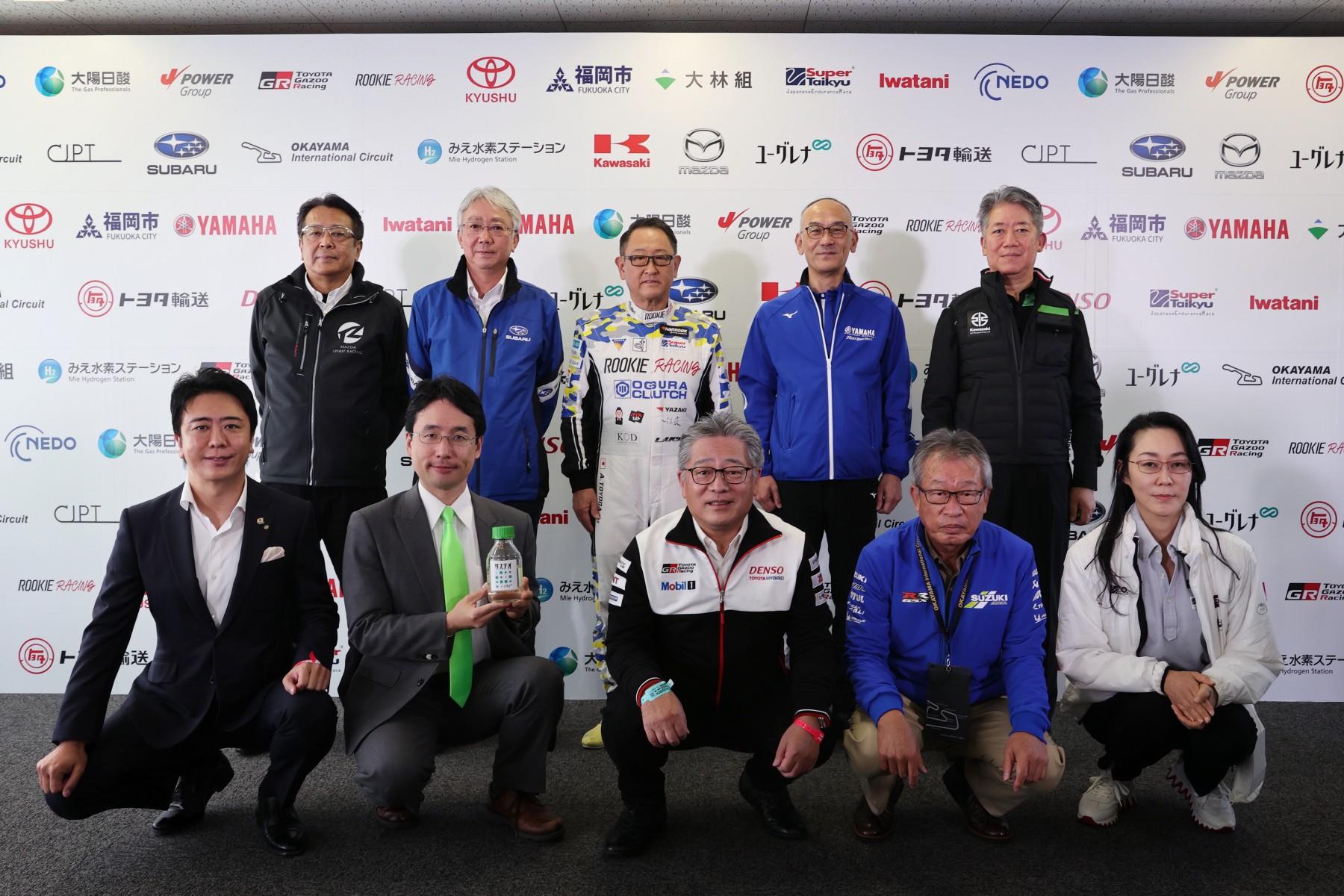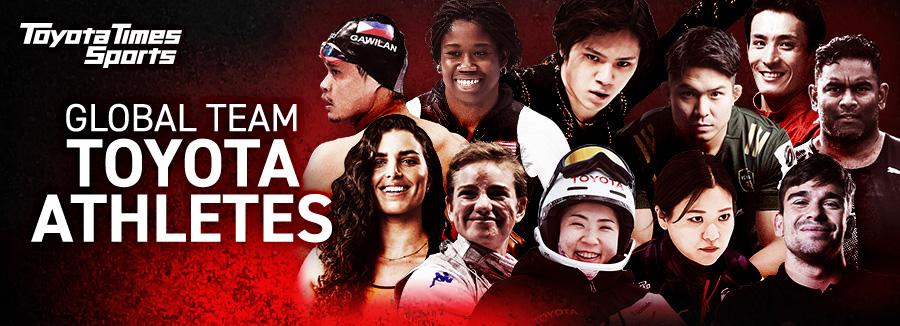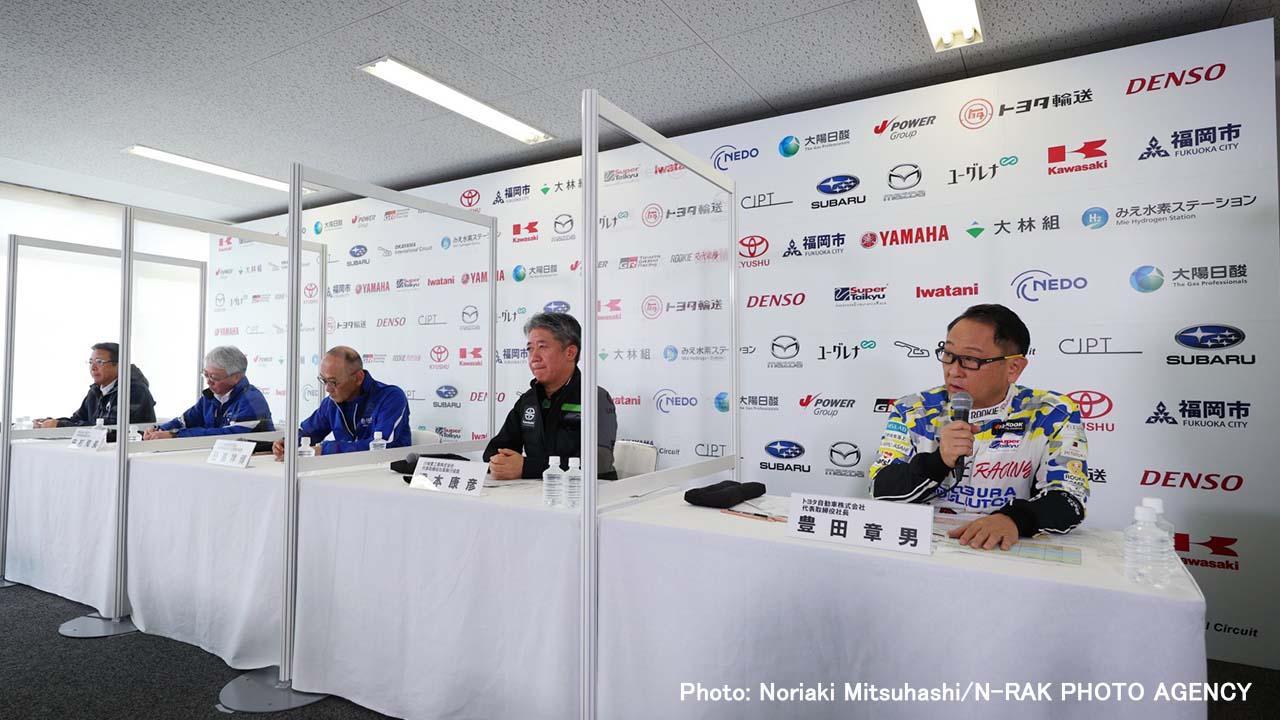
To explore options for carbon neutrality together through motorsports, top executives of car and motorcycle manufacturers who are rarely seen in one place gathered for the last race of 2021 Super Taikyu Series.

Top executives of car and motorcycle manufacturers come together
On November 14, the Corolla Sport equipped with a hydrogen-powered engine completed the final round race of the Super Taikyu Series held at the Okayama International Circuit in Mimasaka City.

This was the fourth race for the hydrogen-powered vehicle. For the past races, the press conferences held on the day of the qualifying session were attended by the top executives of companies that support the challenge of racing with hydrogen. At this race again, present were the presidents of five automobile companies including Toyota.
Joining Toyota President Akio Toyoda were Mazda President Akira Marumoto, Subaru President Tomomi Nakamura, Yamaha Motor President Yoshihiro Hidaka, and Kawasaki Heavy Industries President Yasuhiko Hashimoto—all top executives of car or motorcycle manufacturers.

At the beginning of the press conference, Akio explained about the growing circle of like-minded partners in this challenge.
The Fuji 24 Hours Race in May kicked off our journey to pursuing options for carbon neutrality in the automotive industry.
Over the past six months, our purposeful passion and action in each Super Taikyu round have motivated more like-minded partners to proactively join in our endeavor in their respective field of producing, transporting, and using energy.
This time in Okayama, we are joined by more partners on the using side as a result of expanding the range of energy options.
ROOKIE Racing’s GR Supra and hydrogen-powered Corolla had been the only vehicles in the ST-Q class. But in this race, Mazda has entered a vehicle that runs on biodiesel fuel.
Subaru will be racing with Toyota to demonstrate the carbon-neutral fuel in next year’s Super Taikyu Series.
Toyota has been working with Yamaha Motor since 2016 on developing the performance of hydrogen-powered engines. Furthermore, Yamaha will be teaming up with Kawasaki Heavy Industries to achieve carbon neutrality in the motorcycle industry as well. As I’m one of those who use all five senses to enjoy mobility, I am very much looking forward to their effort.
In this round, we will again be using geothermal-powered hydrogen from Oita prefecture with the cooperation of Obayashi Corporation, sewage-powered hydrogen with the cooperation of Fukuoka City, solar-powered hydrogen from Toyota Motor Kyushu, and in the final, solar-powered hydrogen from Namie Town in Fukushima Prefecture.
For transportation, we use bio-diesel trucks powered by Euglena’s biofuel.
In this way, various companies have begun to demonstrate their evolving technologies in motorsports events. I believe that such purposeful passion and action will change the course of the next 10 to 20 years.
The like-minded partners gathered here love cars, love driving, and love motorsports. I ask that you please continue to support their purposeful actions.
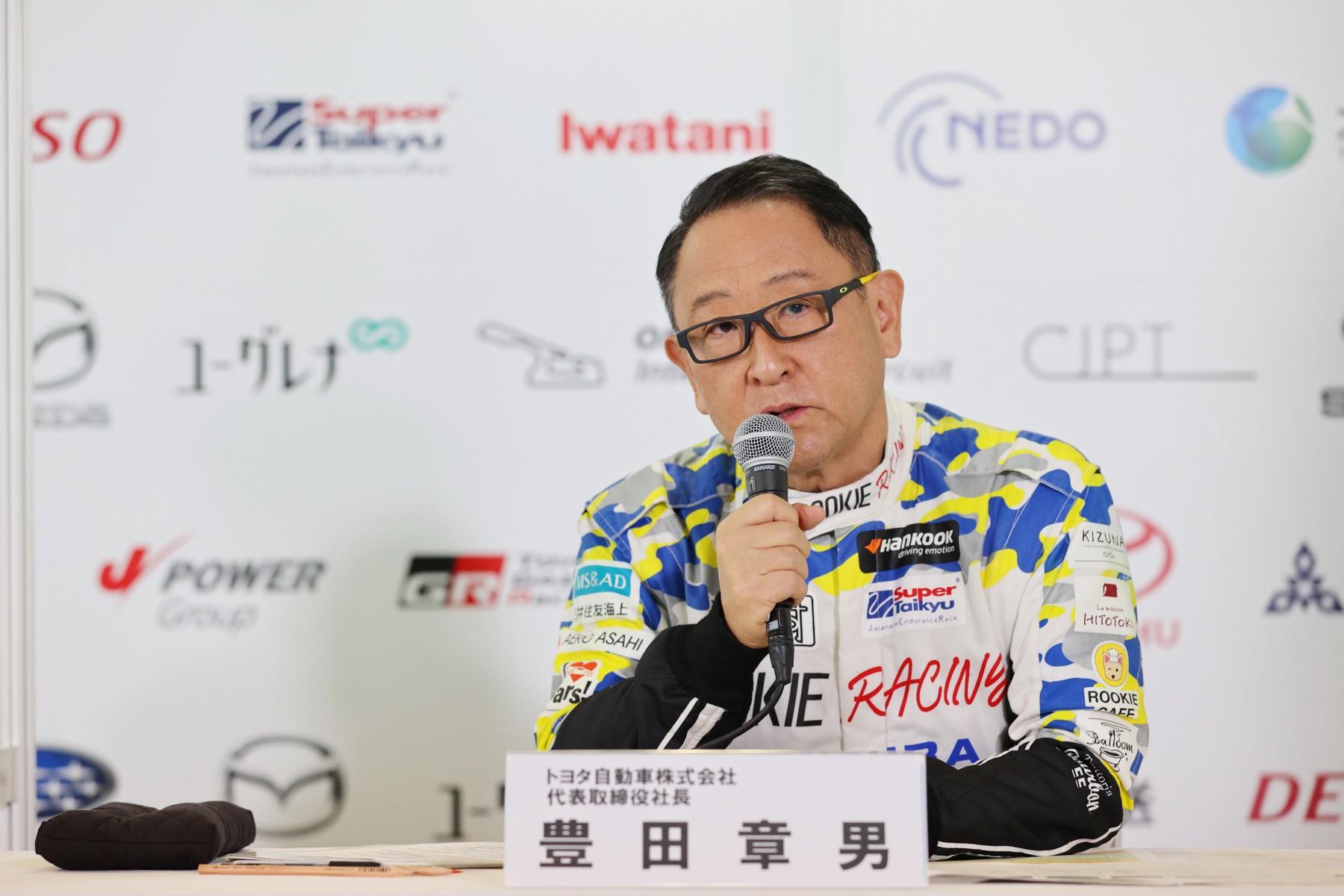
In Fuji Speedway (Oyama, Shizuoka), which was the first race for the hydrogen-powered vehicle, the press conference backboard had eight logos of companies and public bodies. In Okayama, the number increased to 20.
In every race that the hydrogen-powered vehicle has entered, more like-minded partners gathered with new announcements to make.
Toyota Times covers the final round in a two-part article. This first part discusses the efforts being made by the partners that are picking up pace heading into next season.
Mazda: Next-generation biodiesel that does not use a drop of petroleum
In the final round, Mazda’s Demio, which uses next-generation biodiesel fuel, was added to the ST-Q class. This is the category for vehicles at development stages like the hydrogen-powered Corolla.
Mazda President Marumoto explained, “To realize a carbon-neutral society, it is vital to provide a range of options including fuel.”
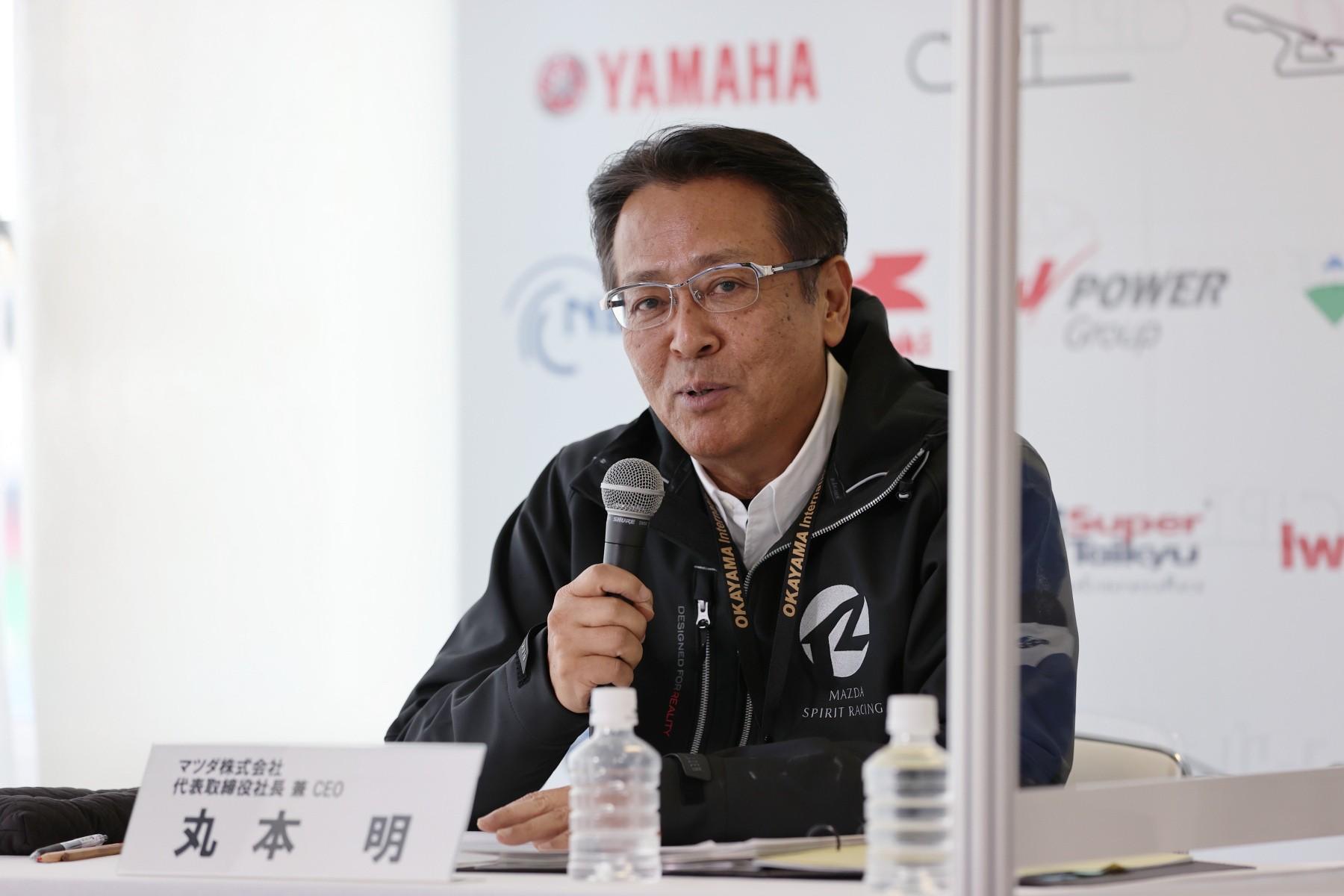
For its fuel, Mazda has chosen “Susteo,” Euglena’s 100% bio-based fuel of which demonstration tests are being conducted in Hiroshima with Mazda’s participation. It is a domestically produced biofuel made from the microalgae Euglena and used cooking oil and does not use a drop of petroleum.
While the Demio entered the Okayama race running on 100% Susteo, the biofuel can also be used in mixture with existing diesel fuel. The molecular structure is the same as that of diesel fuel. Susteo is treated as diesel fuel under JIS standards and the Quality Control Act, and is capable of reducing CO2 emissions in cars that are already on the market.
Susteo is already used for jet engines. “It is a dream technology that has potential in all kinds of engines,” says President Marumoto, who has high expectations for the fuel.
According to Mitsuru Izumo, president of Euglena, the cost is about “10,000 yen per liter.” Nevertheless, he expressed confidence in popularizing the fuel. “We will establish a new plant that is 2,000 times larger and use economies of scale to bring the cost down to a sensible range of about 200 yen per liter by 2025,” he said.
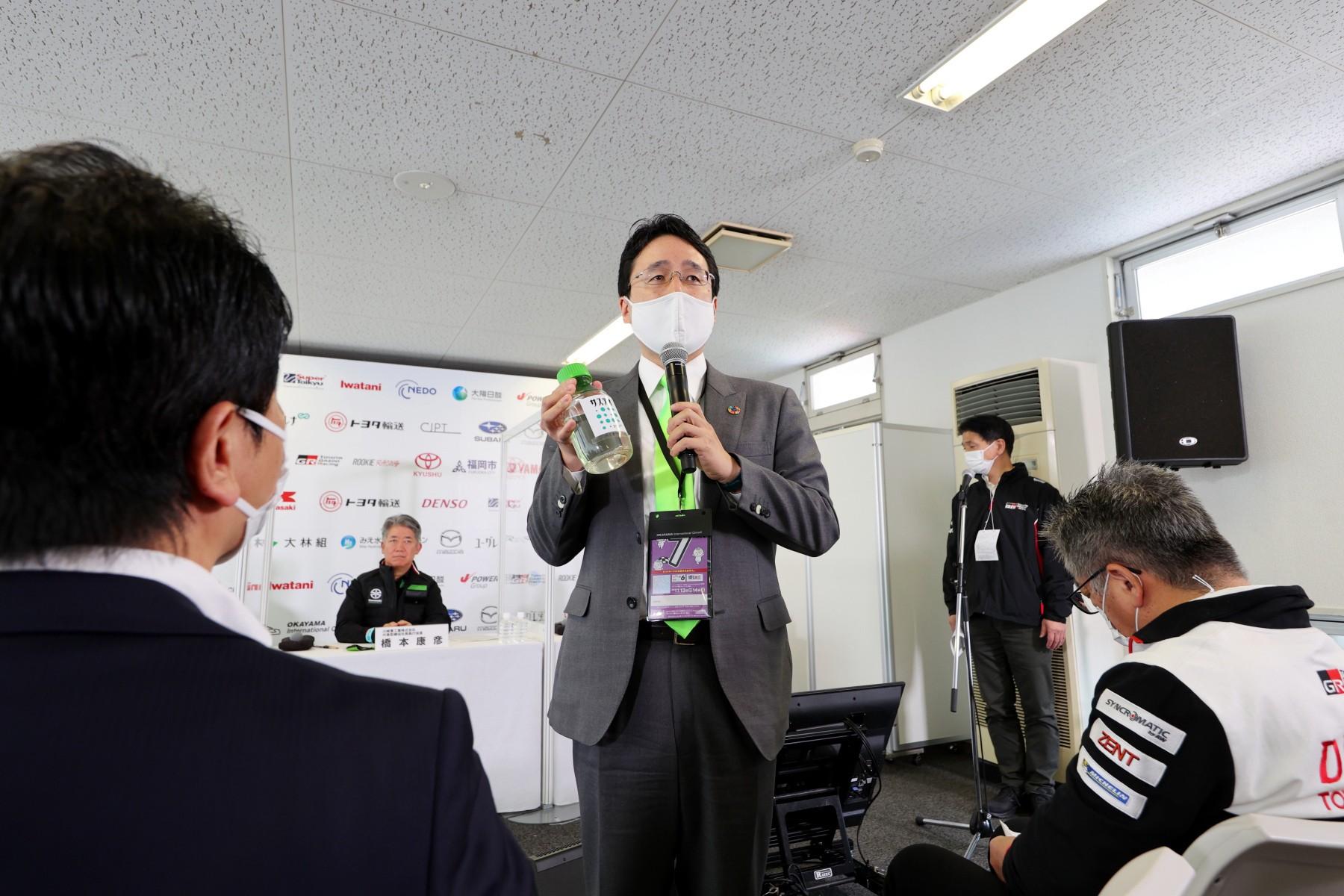
Mazda intends to compete in all rounds of the Super Taikyu Series next season.
Subaru and Toyota: Biomass-derived synthetic fuel
On October 29, Toyota announced the details of the bZ4X, an all-new battery electric vehicle (BEV) jointly developed with Subaru that will launch the “sibling” Solterra. Toyota’s bZ4X is scheduled for worldwide launch in mid-2022.

The two manufacturers, which have joined forces in electric vehicles to achieve carbon neutrality, will enter vehicles that use biomass-derived synthetic fuel in the ST-Q class of next season’s Super Taikyu Series. Subaru and Toyota plan to enter a BRZ-based and a GR86-based vehicle, respectively.
Subaru President Nakamura expressed his determination: “We intend to make steady progress before the eyes of motorsports fans who have a deep understanding of cars. Racing is a head-to-head competition. We will compete with each other, and at the same time, challenge ourselves to achieve carbon neutrality through various options.”
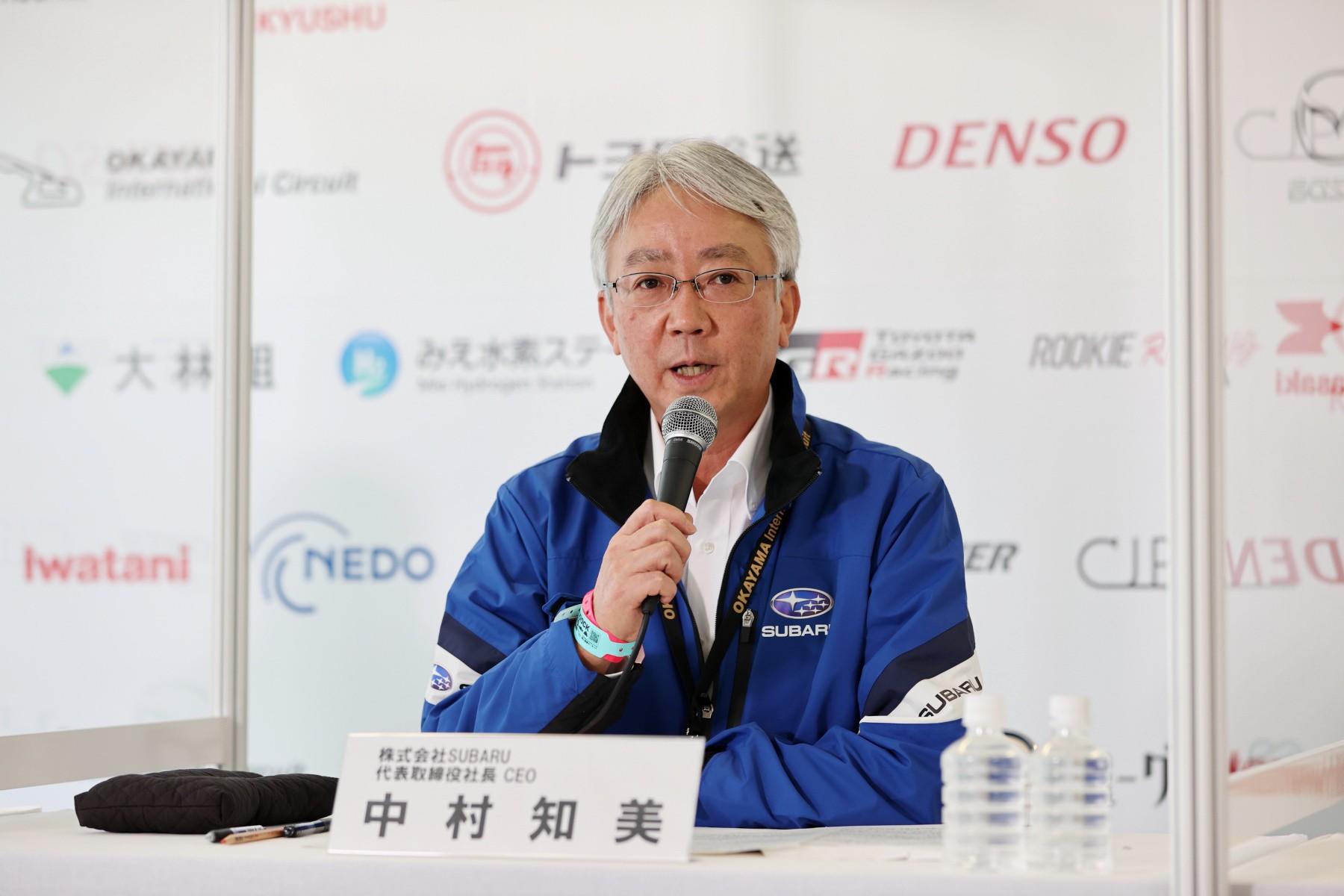
“Having more rivals on the use side is a good thing. [In the ST-Q class] until now, there were only ROOKIE Racing’s GR Supra and the hydrogen-powered Corolla. Mazda’s and Subaru’s joining the fray will give value to reaching the podium,” responded Akio.
The specific type of fuel has not been decided yet, but whatever the fuel, Subaru and Toyota are currently at the stage of identifying the issues. The two manufacturers will accelerate the development while going head-to-head in front of motorsports fans.
Next season, the ST-Q class will feature the hydrogen-powered Corolla, as well as the Demio running on Mazda’s next-generation biodiesel, the Subaru BRZ and the Toyota GR86 running on synthetic fuel.
Fans will be hard-pressed to keep their eyes off the competition to expand the options for a carbon-neutral society.
Kawasaki Heavy Industries and Yamaha Motor: Joint development of the hydrogen engine
Kawasaki Heavy Industries attended the previous press conference as a partner in “transporting” hydrogen made from Australian lignite to Japan. Yamaha Motor, although it’s their first appearance in the race, has been working with Toyota since 2016 to develop hydrogen engines.
The two companies announced that they will begin discussing joint research on hydrogen engines with a view to installing them on motorcycles.
The electrification trend is sweeping through the motorcycle industry as well. In addition to mopeds and scooters, some large electric motorcycles have recently been made available in the market.
Meanwhile, the issue with electrifying large motorcycles, mostly used for leisure rather than daily use, is that it will reduce the fan aspect of motorcycles due to larger and heavier batteries and diminished cruising distance.
The hydrogen engine has many issues to overcome, such as space needed for the fuel tank. Nonetheless, both Yamaha Motor President Hidaka and Kawasaki President Hashimoto are eager about the engine.
President Hidaka described Yamaha Motor as “a company having a stronger commitment to internal combustion engines (ICEs) than any other, as evidenced by the company’s Japanese name Yamaha ‘Hatsudouki’ (meaning engines).” He also shared a story about a local company that has been producing engine parts for more than 60 years and asked Yamaha if the company explores an option to keep ICEs like Toyota.
Regarding hydrogen engines, Kawasaki President Hashimoto expressed: “Our supply chain of ICEs is full of Japan’s excellent technologies. Through hydrogen, we will preserve these advantages together with other companies in Japan.”

While ICEs will be an area of cooperation and competition, Yamaha President Hidaka said, “It will be difficult for parts manufacturers to cooperate (with piping and air intake-related parts that transport hydrogen to the engine) unless they can expect a large volume.”
The companies have approached Honda and Suzuki, and they have begun to explore the possibility of carbon neutrality using ICEs for motorcycles, taking an all-Japan approach.
Expanding the circle of partners picks up pace heading into next season
All of the companies speaking at the press conference are members of the Japan Automobile Manufacturers Association (JAMA).
As chairman of JAMA, Akio has repeatedly said the following:
“No matter how excellent the technology, it is meaningless if it is not chosen and used by customers. We can play the role of pacemaker in terms of making customers’ lifestyles carbon neutral.”
The five companies gathered here are in the B2C business, delivering end products such as motorcycles and cars to customers.
The companies are all aware that no technology, however capable it is, will not come into widespread use unless it is affordable and practical.
The products and technologies developed going forward will be those with the potential to transform people’s lifestyles. Companies will therefore be collaboratively refining and assessing the technologies out in the open in motorsports events as fans look on.
In the lead-up to 2050, together with partners, Toyota will further accelerate the pace of bringing like-minded people on board and developing technology to achieve carbon neutrality.
